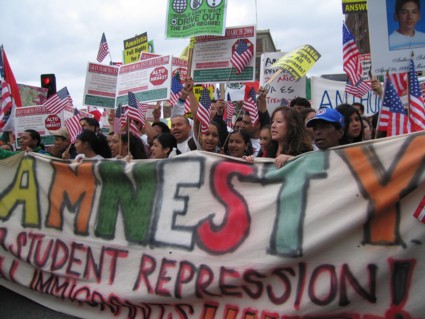
front_line2.jpg, image/jpeg, 425x319
Student protestors march on City Hall. "Compromise" is off the table--the word today was "Amnesty."

front_line2.jpg, image/jpeg, 425x319
LOS ANGELES, 15 April 2006--It only took two weeks for Estudiantes Unidos/Students United to pull the march together. This morning thousands of students, exuberant and determined, marched through downtown to support immigrants, but more to the point, to flex their own political muscle. They found their voice and took their place in what they dubbed "the civil rights movement of this century."
It was still difficult to find a European face, but Asian- and African-descent students were everywhere in the predominantly Mesoamerican crowd. So were parents: moms striding side-by-side with their middle-schoolers, sometimes three generations marching arm-in-arm.
Every half-block of the three blocks of marchers brought a different chant. But this morning there was a new one: "¿Qué queremos? ¡Amnistía! ¿Cuando? ¡Ahora!"
While U.S. flags flags peppered the City Hall lawn, there was no lack of other flags, mostly Mexican, Guatemalan, and Salvadoran. But this crew wasn't opposing Sensenbrenner or supporting a Senate compromise: this was a revolution for raza rights, a full-out call for amnesty for those in the U.S. without papers, and for respect, dignity, and justice for all peoples of color. "Amnesty" from legal sanctions, yes, but just under the surface, amnesty from racial persecution.
The City Hall program began with a call for peace and self-monitoring, and then a tribute to Anthony Soltero. Soltero, a 14-year-old student organizer, took his own life two weeks ago after his vice-principal threatened him with incarceration for putting together a walkout for immigrants' rights, according to his family. His schoolmates took the stage and spoke of the warmth and leadership of their classmate.
The commitment and enthusiasm of the students was inexhaustible. Three students and a teacher from Roosevelt High ran the eight miles of the Sacred Run of the Four Directions, loaded into a car, drove downtown to hook up with other Roosevelt students, walked the length of the march, and returned to the Sacred Run to finish the last mile of the ceremony. The students eagerly collected flyers from the groups represented and for the May 1 Boycott. One flyer, for a showdown with the Minutemen in Burbank next Saturday, was a favorite, with students jostling for copies to hand out to friends.
Meanwhile, according to the Los Angeles Times, Mayor Villaraigosa was in Van Nuys urging students to march outside of school hours, apparently unaware that they were rallying outside his office building doing exactly that.
March organizers had lined up hours of speakers and performers. BAMN, World Can't Wait, and ANSWER-LA each took their turn, but equally notable were the speakers from the Proposition 187 protests and from the Chicano Moratorium and the 60's high school walkouts. Representatives of the African-American community and the state Senate welcomed the ralliers. The students listened with rapt attention to the old school revolutionary messages. East Los Angeles College's ISO raised the roof with their call: "No to a bracero program, no to guestworkers. Yes to legalization, yes to citizenship. ¡Sí se puede--amnistía! Hasta la victoria siempre!"
The walls of City Hall seemed to quiver just a little when the hip-hoppers took to the steps of the staid monolith. "Que viva Zapata!" they invoked, to the roars of the crowd. "This is for the people!"
One student organizer explained what the march had accomplished: "We've raised consciousness that something can be done, that we can fight back and win." What's next? "This isn't just about mobilization. Its about organization."